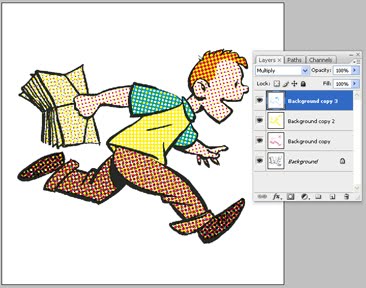So after posting about Four-Color Process, I was looking around to see who is working to preserve this masterful, cheap, laborious-looking halftone printing process. I mean, we brought letterpress back, right?
Well. So far, on the printing front, I’m not quite seeing it; if there are artisanal small-press folks keeping true to the art and technique of old school, cheap, slightly sloppy, pulpy, CYMK, halftone/Ben-Day printing, I haven’t found them.
But it looks like there are book artists–some say illustrators, others hate the term graphic novels, and anyway, they’re not making comic books–who do use halftone techniques. [The only thing they have in common is a love of old dots and a bitterness toward Roy Lichtenstein.]

Just last month, in fact, artist Brian Fies published two lengthy tutorials on using Photoshop for creating halftone images. Having come up using halftone dots, and after skilfully deploying the consciously retro technique in his award-winning book, Whatever Happened to the World of Tomorrow, Fies is able to provide good historical info on how comic illustrations used to be created, and to show how he approximates the original feel using digital tools.
Fies’ technique successfully recreates the halftone style of vintage comics, but only up to the point of printing. One characteristic of crappy 4-color printing is the slight bleed or misalignment of color fields; with his digital perfection, Fies always 4-colors inside the lines.

The other veteran artist, Eddie Campbell, uses halftone sheets very expressively the way they were originally designed, within his analog drawing process. While the results still print up perfectly, Campbell’s conscious, persistent exploration of a seemingly obsolete medium is pretty sweet.
UPDATE: Here’s where I confess my “search” for 4cp didn’t yet actually involve asking any people who I thought might actually know about it. To wit, Andy from Reference Library informs me that the 15th issue of Dot Dot Dot, whose uncracked spine is looking at me right now from my shelf over there, even, apparently set off a bit of a print-on-demand lovewave towards the Risograph V8000 stencil printing machine, which “gives tumblr kids a way to experience registration, moiré, and the good old dot pattern.”
Also, Rollo Press and Ditto both do great Riso work. Below, a beautiful Riso spread from Ditto’s Why Shapes What, with artwork by Vanessa Billy.

Dots, Part 1; Dots, Part 2 [brianfies]
Zipatone-related posts from Eddie Campbell [eddiecampbell]
Skip to content
the making of, by greg allen
